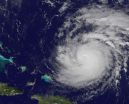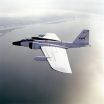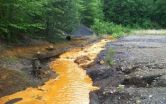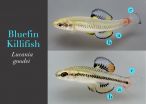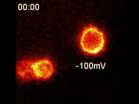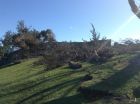(Press-News.org) Tropical Storm Gonzalo strengthened into a hurricane on Oct. 14 when it was near Puerto Rico and provided a natural laboratory for the next phase of NASA's HS3 or Hurricane and Severe Storm Sentinel mission.
The WB-57 aircraft flew over Hurricane Gonzalo on Oct. 15 carrying two HS3 mission instruments called HIWRAP and HIRAD in addition to a new Office of Naval Research sponsored dropsonde system.
The WB-57 is a mid-wing, long-range aircraft capable of operation for extended periods of time from sea level to altitudes in excess of 60,000 feet. Two crew members are positioned at separate tandem stations in the forward section of the fuselage. The WB-57 will fly for approximately 6 hours, has a range of approximately 2,500 miles, and can carry up to 8,800 pounds of payload.
The HIWRAP is the High-altitude Imaging Wind and Rain Airborne Profiler, a "conically scanning" Doppler radar, meaning it scans in a cone-shaped manner. Wind measurements are crucial for understanding and forecasting tropical storms since they are closely tied to the overall dynamics of the storm. The HIWRAP instrument is able to measure line-of-sight (along the radar beam) winds and rain and because it scans in a cone beneath the aircraft, it gets two looks at most parts of the storm, allowing calculations of the 3-D wind and rain fields. In the absence of rain, it can also measure ocean surface winds.
The Hurricane Imaging Radiometer (HIRAD) is a passive microwave radiometer that was developed at NASA's Marshall Space Flight Center, Huntsville, Alabama. HIRAD's purpose is to map out where the strongest winds are in a hurricane. HIRAD provides unique observations of sea surface wind speed, temperature and rain. The data HIRAD gathers will advance understanding and predictability of hurricane intensity. HIRAD's data will also help better determine maximum wind speed and structure of the vortex (spinning center). The region of strongest winds are also much better observed with HIRAD than current capabilities.
The WB-57 aircraft is also testing a new dropsonde system developed by Yankee Environmental Systems. The WB-57's focus is on the upper-level outflow from storms and its connection to the inner-core region.
When the WB-57 investigated Gonzalo it was a Category 4 storm on the Saffir-Simpson Hurricane Scale. According to the National Hurricane Center, Gonzalo is the first category 4 hurricane in the Atlantic basin since Ophelia in 2011.
NOAA's GOES-East satellite captured a visible image of Gonzalo on Oct. 15 at 15:15 UTC (11:15 a.m. EDT) that showed the eye of the storm obscured by high clouds.
The National Hurricane Center noted that NOAA aircraft data and microwave images clearly showed concentric eyewalls, with the inner radius of maximum winds only about 4-5 nautical miles from the center.
An image from the Special Sensor Microwave Imager (SSMI) aboard the Defense Meteorological Satellite Program (DMSP) F-15 satellite taken on Oct. 13 at 07:13 UTC (3:13 a.m. EDT) showed very tiny inner eyewall and a new secondary eyewall, concentric about the center.
At 11 a.m. EDT on Oct. 15, Gonzalo's maximum sustained winds increased to near 130 mph (215 kph) and the National Hurricane Center (NHC) noted that fluctuations in intensity were expected over the next couple of days. Gonzalo's cloud-covered eye was located near latitude 23.5 north and longitude 68.0 west, about 640 miles (1,025 km) south-southwest of Bermuda. Gonzalo was moving toward the northwest near 12 mph (19 kph). The minimum central pressure was reported by an Air Force reconnaissance aircraft was 949 millibars.
The WB-57 has been conducting science missions for the Office of Naval Research in September and will continue through October 2014.
INFORMATION:
The HS3 mission is funded by NASA Headquarters and overseen by NASA's Earth System Science Pathfinder Program at NASA's Langley Research Center in Hampton, Virginia. It is one of five large airborne campaigns operating under the Earth Venture program.
The HS3 mission also involves collaborations with partners including the National Centers for Environmental Prediction, Naval Postgraduate School, Naval Research Laboratory, NOAA's Unmanned Aircraft System Program, Hurricane Research Division and Earth System Research Laboratory, Northrop Grumman Space Technology, National Center for Atmospheric Research, State University of New York at Albany, University of Maryland - Baltimore County, University of Wisconsin, and University of Utah. The HS3 mission is managed by the Earth Science Project Office at NASA Ames Research Center in Moffett Field, California. The WB-57 is housed at NASA's Johnson Space Center in Houston, Texas, home of the NASA WB-57 High Altitude Research Program.
For more information about the HIWRAP, visit:
https://airbornescience.nasa.gov/instrument/HIWRAP
For more information about the HIRAD, visit:
https://airbornescience.nasa.gov/instrument/HIRAD
For more information about the WB-57, visit:
https://airbornescience.nasa.gov/aircraft/WB-57.
For treating patients with prescription opioid dependence in primary care, buprenorphine maintenance therapy is superior to detoxification, according to a new study by Yale School of Medicine researchers published in the Oct. 20 issue of JAMA Internal Medicine.
Prescription opioid dependence has been increasing for the last 15 years and now surpasses heroin dependence. Doctors are also writing more prescriptions for pain management, which has led to higher experimentation and addiction rates, according to lead author David Fiellin, M.D., professor of internal medicine ...
Scientists have developed new geochemical tracers that can identify hydraulic fracturing flowback fluids that have been spilled or released into the environment.
The tracers have been field-tested at a spill site in West Virginia and downstream from an oil and gas brine wastewater treatment plant in Pennsylvania.
"By characterizing the isotopic and geochemical fingerprints of enriched boron and lithium in flowback water from hydraulic fracturing, we can now track the presence of 'frac' fluids in the environment and distinguish them from wastewater coming from other ...
LIVERMORE, Calif. – New medications created by pharmaceutical companies have helped millions of Americans alleviate pain and suffering from their medical conditions. However, the drug creation process often misses many side effects that kill at least 100,000 patients a year, according to the journal Nature.
Lawrence Livermore National Laboratory researchers have discovered a high-tech method of using supercomputers to identify proteins that cause medications to have certain adverse drug reactions (ADR) or side effects. They are using high-performance computers ...
Preexisting differences in the sensitivity of a key part of each individual's immune system to stress confer a greater risk of developing stress-related depression or anxiety, according to a study conducted at the Icahn School of Medicine at Mount Sinai and published October 20 in the Proceedings of the National Academy of Sciences (PNAS).
Inflammation is the immune system's response to infection or disease, and has long been linked to stress. Previous studies have found depression and anxiety to be associated with elevated blood levels of inflammatory molecules ...
CHAMPAIGN, Ill. — They help fish swim, but fins also advertise a fish's social standing and health. In a new study, researchers report that for the male bluefin killifish (Lucania goodei), each colorful fin presents its own messages to other fish.
Researchers report their findings in the journal Behavioral Ecology.
They're called "bluefin" killifish, but the first thing University of Illinois animal biology professor Rebecca Fuller noticed while she was snorkeling in a Florida stream was the killifishes' differently colored fins. In addition to having reflective ...
Fairfax, Va., October 20, 2014—Tumor laterality (left-side vs. right-side) does not impact overall survival in breast cancer patients treated with breast-conserving surgery and adjuvant external beam radiation therapy, according to a study published in the October 1, 2014 issue of the International Journal of Radiation Oncology • Biology • Physics (Red Journal), the official scientific journal of the American Society for Radiation Oncology (ASTRO).
Studies have shown that breast cancer patients treated with radiation therapy have improved local-regional recurrence, ...
VIDEO:
The movie is quantitative imaging of cells with potassium channels, bathed in dilute fluorescent tarantula toxin. Pixel color indicates intensity of tarantula toxin concentration. The circular shapes are cell surfaces,...
Click here for more information.
WOODS HOLE, Mass.--A novel probe that reports on the electrical activity of cells, made by fusing tarantula toxin with a fluorescent compound, is described in a paper today by scientists from the University of California, ...
PULLMAN, Wash.—Researchers led by a Washington State University biologist have found the optimal mechanism by which plants heal the botanical equivalent of a bad sunburn. Their work, published in the Proceedings of the National Academy of Sciences, could lead to the development of crops that can repair the sun's damage more easily, improving yields and profitability.
Helmut Kirchhoff, an assistant professor in WSU's Institute of Biological Chemistry and corresponding author of the PNAS paper, said plants have had to deal with solar damage since the evolution of photosynthesis ...
PHILADELPHIA — Researchers from the Perelman School of Medicine and School of Engineering at the University of Pennsylvania and The Children's Hospital of Philadelphia have used graphene -- a two-dimensional form of carbon only one atom thick -- to fabricate a new type of microelectrode that solves a major problem for investigators looking to understand the intricate circuitry of the brain.
Pinning down the details of how individual neural circuits operate in epilepsy and other neurological disorders requires real-time observation of their locations, firing patterns, ...
Hurricane Gonzalo departed from Bermuda leaving power outages, downed trees, and damaged homes and buildings. An on-the ground account of the storm indicated the eye passed over the island. By Oct. 20, post-tropical storm Gonzalo was approaching the United Kindgom, sparking severe weather warnings.
By Sunday, Oct. 19 Gonzalo was affecting eastern Canada. Forecasters expect Gonzalo to hold together over while traveling east across the North Atlantic where it will affect Scotland as an extra-tropical storm on Tuesday, Oct. 21.
Camille Haley was former NASA intern and ...
